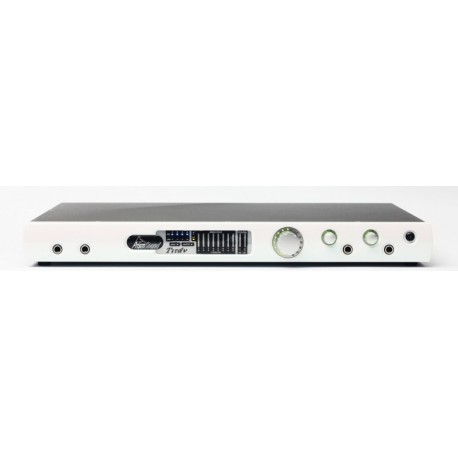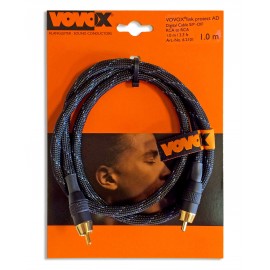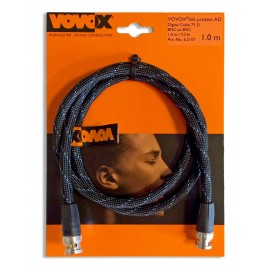No products
Prices are tax included
PRISM SOUND TITAN Recording Interface
Titan is a USB multi-track audio interface for personal recording and sound production, for professional musicians, songwriters, engineers and producers as well as recording studios, post production facilities and scoring stages. Titan is ideal for music and sound recording, mixing, multitracking, overdubbing, stem-based mastering, analogue summing and critical listening applications.
Titan provides Prism Sound's renowned performance, sound quality and state-of-the-art clock technology in a dedicated unit compatible with both Windows (Vista, 7 and 8, 32 and 64 bit, ASIO as well as MAC OS X 10.4.11 and later (Intel). Once configured with a computer, Titan can also operate stand-alone using its ADAT, S/PDIF or AES3 I/O.
Signal path
Eight analogue input channels and up to 10 digital input channels are available as inputs for your audio workstation software through the host computer's audio driver. Similarly, eight analogue output channels, up to 10 digital output channels and stereo headphone outputs can play 20 different channels. For low-latency foldback or monitoring to headphones or main outputs, each output pair (1-2, 3-4 etc or the headphone output) can optionally be driven from the built-in DSP mixer with an individual local mix of any selection of inputs through the controller applet. All analogue inputs are electronically balanced with automatic unbalanced operation. Analogue outputs are electronically balanced with 'bootstrapping', i.e. level is maintained if one leg is grounded.
Multichannel Digital Input and Output (MDIO) expansion
As well as the built-in inputs and outputs Titan can accommodate other optional digital interfaces such as Pro Tools | HDX and AES3 multichannel options through its MDIO expansion slot. This flexibility makes Titan perfectly suitable for the home, native or project studio as well as larger multitracking facilities by seamless, reliable integration with the industry standard platforms. The MDIO expansion means Titan is future-proof allowing further digital interface options to be developed and available such as Thunderbolt (to be confirmed).
No-compromise, full Prism Sound audio quality
Titan makes no compromises on audio quality. It is the result of years of research and development into digital audio conversion and extensive dialogue with Prism Sound's customers.
Titan draws on Prism Sound's years of experience in developing digital audio products, including its range of audio test equipment, adopted by a wide variety of clients across the audio industry from pro-audio to consumer electronics. This experience means that Titan is well-behaved both as a computer peripheral and an audio processor.
Reliability is vitally important in professional recording. Prism Sound has always made extensive use of precise software calibration techniques in its converters - pots and tweaks are always unreliable, so there are none.
The design team has gone to great lengths to minimise noise and interference, in particular hum. All of the analogue circuits have galvanic isolation, while the unit's electronically balanced I/O allows it to handle common mode interference sources as well as enabling trouble-free connection to unbalanced equipment.
It is often said that THD+N figures do not always correlate well with the perception of sound quality and this is true - partly because the traditional measures of THD+N or SINAD expressed as RMS figures are rather a broad measure. With this in mind, we have taken great care to make sure that not only is the Titan noise and distortion spectrum beyond reproach, but the RMS distortion result measures up to the state of the art.
Standards compliant USB interface
Prism Sound has taken on board the increasing importance of native processing power for professional users and the fact that software products for standard PC and Mac platforms have been greatly enhanced in recent years. Titan uses a USB2 interface. This is a UAC2 (USB Audio Class 2) interface supported natively in Mac, iPad, Linux and Android, and in Windows via a driver.
Titan is easy to connect to your computer and to your outboard gear. For both Mac and PC platforms, there is a controller application to configure the unit and control its built-in mixer and other functions. Aside from the monitor and headphone level controls, everything else is operated solely from the Titan controller application. The controller software opens on-screen as a separate panel alongside your existing editing software.
Flexible Inputs and Outputs
Our customers told us that many professional users wanted a highly integrated solution with instrument and microphone inputs, and line outputs that could be used for stereo or multi-channel monitoring and/or foldback to performers. Titan offers eight analogue recording channels, eight monitoring outputs, stereo digital input and output on a phono connector plus concurrent optical digital I/O ports that can interface to S/PDIF or ADAT data formats, giving Titan a maximum capability of 18 concurrent input and output channels plus stereo headphones.
Titan's eight analogue inputs support various capabilities. Titan has four high-grade microphone pre-amps with software-controlled gain in 1dB steps, individually-switchable phantom power, 20dB pads - and very low noise and distortion. These combo connector inputs support both microphone and line input, with digitally-controlled mic gain in excess of 60dB. Two front panel inputs also support direct injection (DI) instrument connections with quarter-inch jacks. RIAA Equalization can be selected in the controller applet on channels 1 & 2 so that turntables can be connected for archiving or sampling applications. By selecting the input type (Mic or DI) , low- or high-impedance cartridges can be loaded with suitable termination impedances. All analogue inputs have individually-selectable Prism Sound "Overkillers" built in, just as on the higher-priced ADA-8XR, to catch those fast transients. The Overkiller threshold automatically follows the operating line-up level selection (+4dBu or -10dBV). Overkillers are ideal for percussive sounds, particularly drums, where headroom can be a problem.
The co-axial digital I/O port can be switched in the Titan controller applet between S/PDIF and AES3 formats. This control changes the operating voltage and the Channel Status format and is complemented by two in-line adaptor leads that provide external XLR connections for AES3 devices. Other connections include wordclock sync I/O.
Titan can also operate in a stand-alone mode using its ADAT or co-axial digital I/O connections. Once set up using the Titan controller applet, the unit can be disconnected from the host computer and used independently. Titan will retain its settings when powered down so even if it is switched off, Titan can be re-powered and stand-alone operation can continue with the automatically-stored settings.
Digital Mixer
Our customers also identified a need for a unit that could provide low latency foldback to performers, particularly when tracking and overdubbing. In answer to this need, Titan has a powerful built-in digital mixer that can be configured from the host computer to provide foldback feeds to performers, each with their own stereo mix of workstation playback and any of the inputs.
The question of latency in computer interfaces, especially USB and FireWire boxes, is an important one. Obviously there are situations where the round-trip latency needs to be really short, like in overdubbing. The problem is that even if the latency on the interface and in the driver is as short as it could ever be, a native DAW is busy with plug-ins and other software and buffer times are probably set long. The only answer is to provide local foldback mixing in the interface. This is not new, and other products feature it, but most local mixers in competitive products are just too basic. Titan provides 'console quality' local mixing - every output has its own independent mixer, with channel strips for all inputs and workstation feeds, complete with fader, pan/balance pot, solo and mute buttons, and full metering. Strips can be stereo or mono, and the mixes are dithered with filtered coefficients, just as in a top-end digital mixer.
There is a very small residual delay through the A/D and D/A conversion process in the foldback path, mostly from filters used for decimation and interpolation. However, with the low-latency Prism Sound DSP mixer, the worst-case delay through the A/D and D/A path is only 0.5ms and is significantly less at higher sampling rates. This is generally reckoned to be small enough not to be problematic.
Although the unit's outputs will mainly be used for monitoring or foldback, the fact that they are of such high quality makes them suitable for a range of other applications such as insertion points, analogue summing or stem-based mastering.
Flexible Monitoring
Professional users demand more sophisticated monitoring capabilities and are getting used to surround sound with HDTV and DVD, so it is becoming important to support surround monitoring setups.
As well as wanting great analogue recording channels, the DAW user also needs top-quality monitoring. The eight analogue outputs on Titan allow monitor setups from multi-stereo up to 7.1 surround. Titan has a real volume knob with mute function which can be assigned to any or all of the analogue or digital outputs for use as a control room monitor control. There are two headphone amps, suitable for all types of headphones, each with its own independent volume control. As well as having its own workstation feed and mixer, the headphones can also be quickly switched across the other output pairs, which is handy for setting up.
Sample Rate Conversion and Noise Shaping
The digital output is equipped with the four Prism Sound SNS noise-shaping curves and includes Prism Sound's renowned synchronous sample-rate conversion, allowing outputs to various external devices at other sampling rates. The sample-rate converter can be used at the outputs as well as the inputs, so as well as dealing with unsynchronised or wrong-rate digital inputs, Titan can also generate, say, a live 44.1kHz output from a 96kHz session. Since Titan also includes the full suite of the famous Prism Sound 'SNS' noise shapers, you can also reduce to 16-bits at mastering-house quality.
Unsurpassed Jitter Rejection
In the 1990s Prism Sound pioneered testing of sampling and interface jitter and as a result our digital audio products deliver unsurpassed jitter rejection. Prism Sound digital audio products lock up fast and re-generate ultra-stable clock outputs. Another aspect of the traditional Prism Sound converter that is retained was the clocking - it's just as important as analogue-path considerations sound-wise. So whether it's providing a high-quality master clock for the rest of the room, or dealing with a jittery clock from outside, Titan is as rock-steady as its forbears.
Support
Over the years, Prism Sound's reputation for audio quality has been matched by its reputation for after-sales support and technical advice. Titan has the benefit of that support and customers have access to one of the best technical teams in the business.
The Last Word
We believe that Titan delivers exactly what our personal studio customers have asked for - all the performance of a Prism Sound product in a dedicated USB unit that handles line, microphone and instrument inputs with good foldback and monitoring capabilities, yet at a more accessible price tag. We are confident that customers using the new Titan converter will agree that it sounds as good as it looks.







